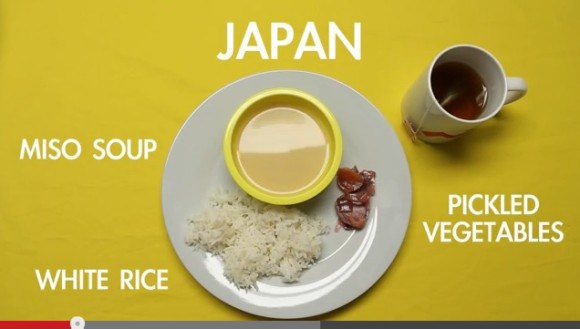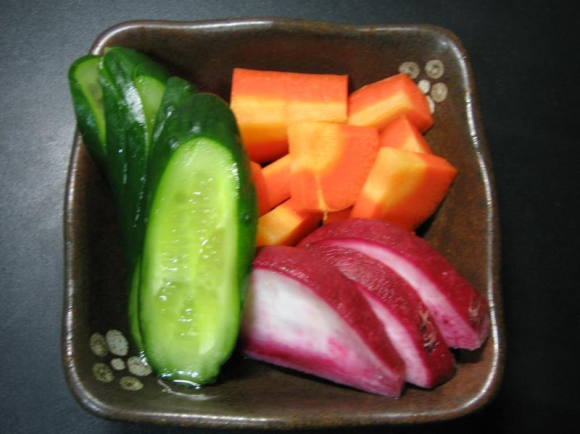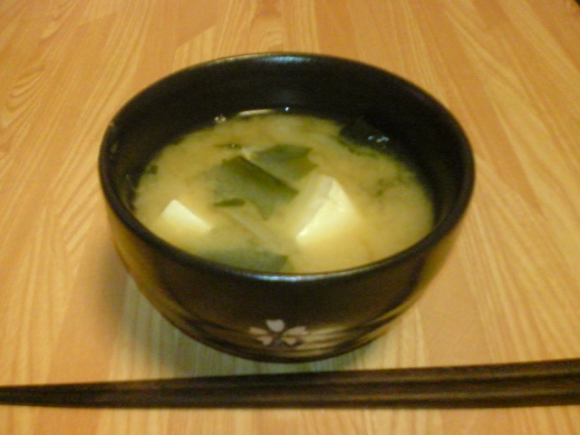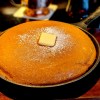
There’s a certain mystery about what different countries have for breakfast. Most people’s contact with the eating habits of other nations comes from dining out, so as long as you’ve got a Japanese restaurant near where you live, you don’t necessarily need to fly to Tokyo to see what a typical lunch or dinner looks like.
Unless you grew up in a culture, though, you might not have had the chance to see what the locals eat for their first meal of the day though. We recently came across a video that aims to shed a little light on the subject, and while we’re intrigued by the premise, they sort of dropped the ball on what Japan eats at breakfast.
The video’s self-explanatory title is What Does the World Eat for Breakfast?. In it, we see an overhead shot of a table, with a pair of hands swapping foods representing each country in and out.
The video is just under two minutes long, and runs through about 20 different nations. Unfortunately, when you’re moving at such a breakneck pace, a few mistakes are bound to pop up, and we have to say the menu for Japan is a little off.
On the one hand, the items displayed, miso soup, white rice, and pickled vegetables, are all indeed traditional components of a Japanese morning meal. However, that’s an amazingly austere lineup even by Japanese standards. It’s a little like saying Americans have toast and coffee for breakfast, and that’s all.
Sure, if you search long enough, you might be able to find someone in Japan who starts his day off with this bare-minimum of a meal. He’s more likely to be a hermit living alone in the mountains than a regular member of modern society, though.
Aside from the healthy yet unfulfilling items shown, Japanese-style breakfasts generally include fish (usually salmon) and the sweetened style of fried egg called tamago-yaki. In east Japan, the pungent fermented soy beans called natto are also a regular fixture.
Not to mention the bane of exchange students trying to culturally assimilate
Still, it is true that Japanese do often the foods that appear in the video. The thing is, they don’t really eat the kind of rice, miso soup, and pickles that are shown.
For starters, that rice looks pretty dry. Most Japanese rice is a shorter grain that soaks up extra moisture, making it fluffier and more flavorful. It’s also a lot easier to eat more or less on its own.
The pickles used in the video are a bit of an odd choice, too. That thin-sliced variety, known as fukujintzuke, is made by pickling the vegetables in soy sauce. Fukujintzuke pickles aren’t really meant to be eaten by themselves like this, though. In general, they’re used as a garnish for curry and rice. Their role is more to add a little variety to the appearance and texture of a meal, not be a dish in and of themselves.
Ordinarily, Japanese breakfasts implement nukatzuke pickles, which are made from larger chunks of vegetables and have a milder flavor.
Finally, the miso soup in this video is, for lack of a better word, kind of depressing. The pale yellow color is a little funky, but the real problem here is that there’s absolutely nothing but broth in that bowl. You’d never mistake authentic, traditional miso soup for a hearty stew, but at the very least you’ll find slices of green onions, small cubes of tofu, or a few strips of seaweed floating in it, even with the cheapest instant brands.
To the video’s credit, it does have the beginning building blocks of breakfast in Japan. Now it just needs to finish it off.
Top image, video: YouTube
Insert images: Wikipedia (1, 2)
[ Read in Japanese ]



 What’s really for breakfast? 20 Japanese people give us a peek at their morning meal【Photos】
What’s really for breakfast? 20 Japanese people give us a peek at their morning meal【Photos】 We try chucking our lunchtime bento into a pan of soup, result is doubly delicious
We try chucking our lunchtime bento into a pan of soup, result is doubly delicious This mouth-watering Japanese breakfast is from…a restaurant in New York?!?
This mouth-watering Japanese breakfast is from…a restaurant in New York?!? The best place to eat Japanese breakfast for US$2: Cheap food hack for locals and tourists
The best place to eat Japanese breakfast for US$2: Cheap food hack for locals and tourists We eat a luxurious Japanese-style buffet breakfast in a restaurant full of wood-carved bears
We eat a luxurious Japanese-style buffet breakfast in a restaurant full of wood-carved bears Foreigner’s request for help in Tokyo makes us sad for the state of society
Foreigner’s request for help in Tokyo makes us sad for the state of society Historical figures get manga makeovers from artists of Spy x Family, My Hero Academia and more
Historical figures get manga makeovers from artists of Spy x Family, My Hero Academia and more Japanese city loses residents’ personal data, which was on paper being transported on a windy day
Japanese city loses residents’ personal data, which was on paper being transported on a windy day Suntory x Super Mario collaboration creates a clever way to transform into Mario【Videos】
Suntory x Super Mario collaboration creates a clever way to transform into Mario【Videos】 Ghibli Park now selling “Grilled Frogs” from food cart in Valley of Witches
Ghibli Park now selling “Grilled Frogs” from food cart in Valley of Witches Red light district sushi restaurant in Tokyo shows us just how wrong we were about it
Red light district sushi restaurant in Tokyo shows us just how wrong we were about it Osaka governor suggests lowering voting age to 0 to curb population decline
Osaka governor suggests lowering voting age to 0 to curb population decline Harajuku Station’s beautiful old wooden building is set to return, with a new complex around it
Harajuku Station’s beautiful old wooden building is set to return, with a new complex around it We try epic pancakes at Japanese coffeehouse chain Doutor
We try epic pancakes at Japanese coffeehouse chain Doutor Akihabara pop-up shop sells goods made by Japanese prison inmates
Akihabara pop-up shop sells goods made by Japanese prison inmates McDonald’s new Happy Meals offer up cute and practical Sanrio lifestyle goods
McDonald’s new Happy Meals offer up cute and practical Sanrio lifestyle goods Japanese ramen restaurants under pressure from new yen banknotes
Japanese ramen restaurants under pressure from new yen banknotes French Fries Bread in Tokyo’s Shibuya becomes a hit on social media
French Fries Bread in Tokyo’s Shibuya becomes a hit on social media Studio Ghibli releases new action figures featuring Nausicaä of the Valley of the Wind characters
Studio Ghibli releases new action figures featuring Nausicaä of the Valley of the Wind characters New private rooms on Tokaido Shinkansen change the way we travel from Tokyo to Kyoto
New private rooms on Tokaido Shinkansen change the way we travel from Tokyo to Kyoto Tokyo Tsukiji fish market site to be redeveloped with 50,000-seat stadium, hotel, shopping center
Tokyo Tsukiji fish market site to be redeveloped with 50,000-seat stadium, hotel, shopping center All-you-can-drink Starbucks and amazing views part of Tokyo’s new 170 meter-high sky lounge
All-you-can-drink Starbucks and amazing views part of Tokyo’s new 170 meter-high sky lounge Beautiful Ghibli sealing wax kits let you create accessories and elegant letter decorations【Pics】
Beautiful Ghibli sealing wax kits let you create accessories and elegant letter decorations【Pics】 Studio Ghibli releases Kiki’s Delivery Service chocolate cake pouches in Japan
Studio Ghibli releases Kiki’s Delivery Service chocolate cake pouches in Japan New definition of “Japanese whiskey” goes into effect to prevent fakes from fooling overseas buyers
New definition of “Japanese whiskey” goes into effect to prevent fakes from fooling overseas buyers Our Japanese reporter visits Costco in the U.S., finds super American and very Japanese things
Our Japanese reporter visits Costco in the U.S., finds super American and very Japanese things Studio Ghibli unveils Mother’s Day gift set that captures the love in My Neighbour Totoro
Studio Ghibli unveils Mother’s Day gift set that captures the love in My Neighbour Totoro More foreign tourists than ever before in history visited Japan last month
More foreign tourists than ever before in history visited Japan last month New Pokémon cakes let you eat your way through Pikachu and all the Eevee evolutions
New Pokémon cakes let you eat your way through Pikachu and all the Eevee evolutions Sales of Japan’s most convenient train ticket/shopping payment cards suspended indefinitely
Sales of Japan’s most convenient train ticket/shopping payment cards suspended indefinitely Sold-out Studio Ghibli desktop humidifiers are back so Totoro can help you through the dry season
Sold-out Studio Ghibli desktop humidifiers are back so Totoro can help you through the dry season Japanese government to make first change to romanization spelling rules since the 1950s
Japanese government to make first change to romanization spelling rules since the 1950s Ghibli founders Toshio Suzuki and Hayao Miyazaki contribute to Japanese whisky Totoro label design
Ghibli founders Toshio Suzuki and Hayao Miyazaki contribute to Japanese whisky Totoro label design Doraemon found buried at sea as scene from 1993 anime becomes real life【Photos】
Doraemon found buried at sea as scene from 1993 anime becomes real life【Photos】 Tokyo’s most famous Starbucks is closed
Tokyo’s most famous Starbucks is closed One Piece characters’ nationalities revealed, but fans have mixed opinions
One Piece characters’ nationalities revealed, but fans have mixed opinions We asked a Uniqlo employee what four things we should buy and their suggestions didn’t disappoint
We asked a Uniqlo employee what four things we should buy and their suggestions didn’t disappoint Princesses, fruits, and blacksmiths: Study reveals the 30 most unusual family names in Japan
Princesses, fruits, and blacksmiths: Study reveals the 30 most unusual family names in Japan This just might be the best affordable hotel breakfast buffet in all of Japan【Photos】
This just might be the best affordable hotel breakfast buffet in all of Japan【Photos】 How to get a beef bowl breakfast in Japan for only 290 yen (some assembly required)
How to get a beef bowl breakfast in Japan for only 290 yen (some assembly required) Former sushi chef serves onigiri rice balls for breakfast at new morning restaurant in Japan
Former sushi chef serves onigiri rice balls for breakfast at new morning restaurant in Japan Can we replace tofu with cheese in miso soup? We find out【SoraKitchen】
Can we replace tofu with cheese in miso soup? We find out【SoraKitchen】 How to turn konbini food into a luxury Japanese meal
How to turn konbini food into a luxury Japanese meal We try Japan’s top-ranked hotel breakfast for ourselves, find out if it’s worth the trip to Kobe
We try Japan’s top-ranked hotel breakfast for ourselves, find out if it’s worth the trip to Kobe The depressing diet of a Tokyo prostitute during Japan’s Edo period
The depressing diet of a Tokyo prostitute during Japan’s Edo period Around Japan in 47 rice balls: Mr. Sato buys each prefecture’s musubi all from one Tokyo shop
Around Japan in 47 rice balls: Mr. Sato buys each prefecture’s musubi all from one Tokyo shop Soup curry and onigiri for breakfast at a super tasty semi-secret spot in Tokyo’s Shinjuku
Soup curry and onigiri for breakfast at a super tasty semi-secret spot in Tokyo’s Shinjuku For just US$2.50, this beef bowl chain might have the best-value breakfast in Japan
For just US$2.50, this beef bowl chain might have the best-value breakfast in Japan Kansai and Kanto prove again that they are each distinct regions when it comes to food
Kansai and Kanto prove again that they are each distinct regions when it comes to food Kawaii Miso Soup Harajuku Flavor commercial delves deep into the roots of kawaii【Video】
Kawaii Miso Soup Harajuku Flavor commercial delves deep into the roots of kawaii【Video】 We try “Japan’s best-selling miso soup” and it melts the cold in our bones
We try “Japan’s best-selling miso soup” and it melts the cold in our bones This “Texas Pile” set lured us into a fried chicken shop for the first time, and we have no regrets
This “Texas Pile” set lured us into a fried chicken shop for the first time, and we have no regrets Bacon and Egg Sauce Katsudon: A new way to eat breakfast in Japan
Bacon and Egg Sauce Katsudon: A new way to eat breakfast in Japan
Leave a Reply